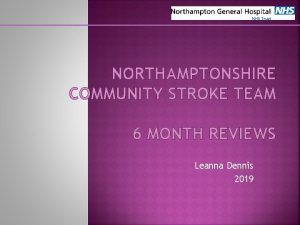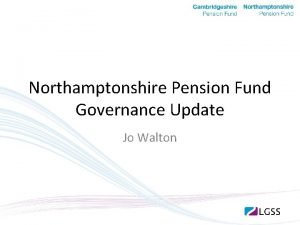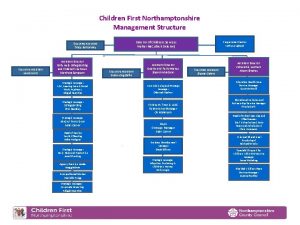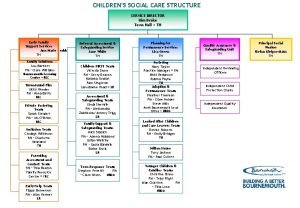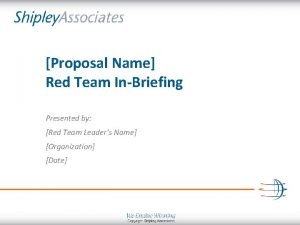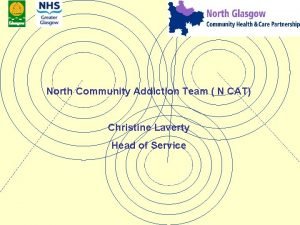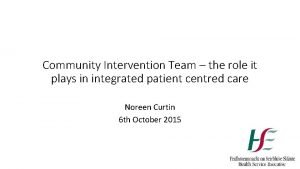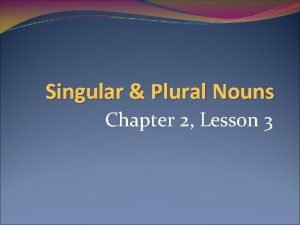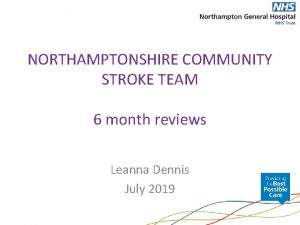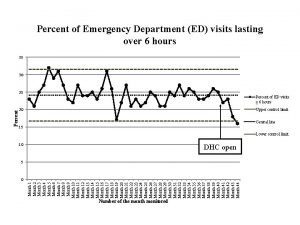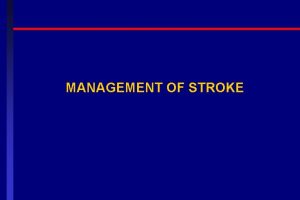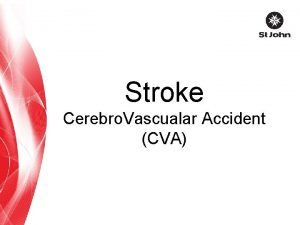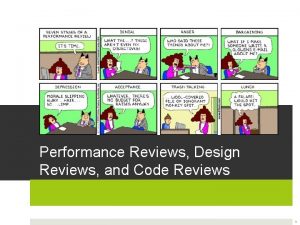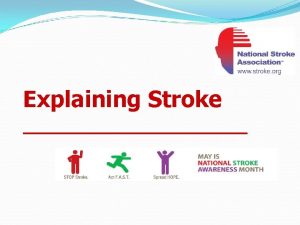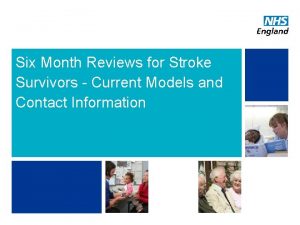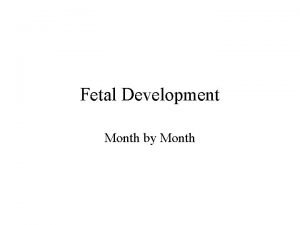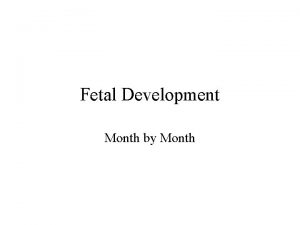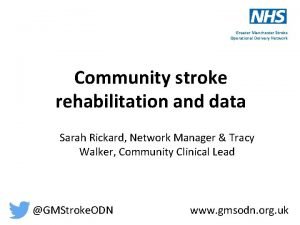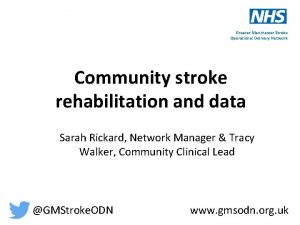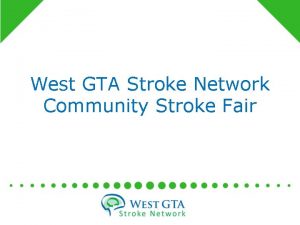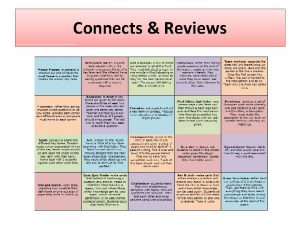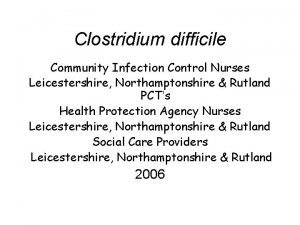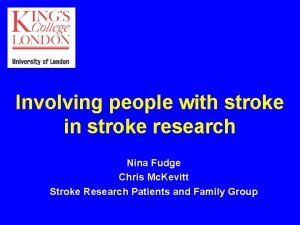NORTHAMPTONSHIRE COMMUNITY STROKE TEAM 6 MONTH REVIEWS Leanna























- Slides: 23

NORTHAMPTONSHIRE COMMUNITY STROKE TEAM 6 MONTH REVIEWS Leanna Dennis 2019

SUMMARY What is a 6 -month review? Why are they important? Benefits GMSAT Review tool Types of reviews Process I undertake – discussion Stats Reflections Conclusions

WHAT IS A 6 MR? Stroke is a long term condition. As such, survivors experience changes (both positive and negative) in their needs over time. A 6 month review is a holistic review of a stroke patients needs at 6 months post the date of stroke. An unmet need is a life area that the individual post stroke requires assistance or advice to improve. This should be completed by a medical professional or an individual supported by an organisation with expert knowledge of stroke.

WHY ARE THEY IMPORTANT? For many, the full impact of a stroke is only realised following discharge from hospital or community rehabilitation when they are left to suddenly adjust to the full impact of the stroke on their life at home. It is at this stage that many report a sense of ‘abandonment’ and have difficulty accessing the services they need to address their long term unmet needs. Reviews can help ensure patients and carers receive appropriate support and access to services as their needs require.

WHY ARE THEY IMPORTANT? The recommendation for 6 month reviews, reflected in national policy, are drawn from clinical consensus rather than from evidence of benefit. NSF for older people (2001) National Stroke Strategy (QM 14) Department of Health’s 2010/11 Accelerating Stroke Improvement Programme RCP National Clinical Guidelines (2008) NICE Rehabilitation Guidelines 2013 CQC review on stroke care (2011) NHS IQ guidance on LTC commissioning and improving adult rehabilitation services (2015) RCP Guidelines 2016 CCG’s

WHY ARE THEY IMPORTANT? These state all stroke survivors and their carers should receive a six month (after they leave hospital) review of their health and social care needs to ensure they feel supported in the long term. It is seen as a way to provide access to further specialist review, advice, information, support and rehabilitation where appropriate. This should include medical, psychological, social, emotional and individualised (needs based) interventions and advice. Aim is that 100% of stroke survivors get a review.

6 MONTH REVIEWS Benefits Increased understanding of stroke Avoidance of hospital admission (avoiding escalation of problems) Identification of secondary prevention needs (e. g. undiagnosed atrial fibrillation, hypertension, medications management) and the modification of risk factors Reduced GP and stroke consultant appointments Identification of mood and relationship issues that otherwise might be missed or not mentioned

6 MONTH REVIEWS Opportunity to reduce dependency Reduce adult services care package and care home placements Reduced duplication between services. Improved joint working across agencies Potential to improve access to voluntary sector support services (by highlighting areas where voluntary services can meet needs) Continuity of care and reassurance Identification of carer needs

6 MONTH REVIEWS Improved ability to cope and self-manage, increased independence More progress than expected for stroke survivors in rehabilitation Improved quality of life Goal driven review processes may help to increase patient engagement in recovery and self-efficacy which can support patients to manage their conditions effectively and to affect lifestyle changes Opportunities for improved data collection processes, audit, improving performance monitoring and inform service development needs

Film. . 6 MR Filming6 -month review film. wmv

ADMIN PROCESS Email discharge to CST admin with the following information: Type of review required ie: Telephone/Home/Clinic & person you wish to complete the review (not anyone) Complete set of patient notes to be returned to NGH Reviews sorted a month in advance Check RIP/current address/GP Book calendar & send letter & questionnaire

ADMIN PROCESS Once review booked, admin only to move On caseload – 8 month review Move review to 8 months, any reviews done post 8 months the data will not be entered on SSNAP Commissioned to do them If the review doesn’t take place – email CST admin & send patient pack back to NGH

GMSAT The Greater Manchester Stroke Assessment Tool (GM-SAT) A simple, evidence-based assessment tool which can be used to identify and address individuals’ unmet post-stroke needs from across health, social and emotional care domains It encompasses a holistic review of 38 areas of potential post-stroke care needs from medication management and secondary prevention through to mood and fatigue, including those required by the Care Quality Commission’s Stroke Service Review and the ASI Programme. (Literature review, Professional consultation and service user response)

GMSAT Together with its supporting materials, it provides everything needed to undertake a six month review Liaised with team and localised to service needs and Northamptonshire. GMSAT Algorithms document Annually reviewed.

PAPERWORK Complete patients notes/Additional patient information Questionnaire – for review Algorithm - GMSAT 6 MR Proforma Modified Rankin SSNAP consent form Admin to send 6 MR outcome letter

TYPES OF REVIEW Not seen by CST/6 month only Telephone Home visit – home or care home Clinics

TYPES OF REVIEW Not seen by CST 6 month review only pack Patient Questionnaire – any ticks Start with those issues Algorithm Mood / Secondary prevention Discuss any referrals and why Get consent for referrals SSNAP consent

TYPES OF REVIEW Telephone Review discharge summary and goals – maintaining? SSNAP consent Patient Questionnaire – any ticks Start with those issues Algorithm questions Discuss any referrals and why Get consent for referrals

TYPES OF REVIEW Home visit – home or care home Liaise with nurse in charge (care home) Typical day for the patient (positioning, activities, quality of life) Goals – maintaining (if seen before) Any areas where deteriorated Algorithm questions Review patient via conversation or discussion with nursing staff and family Physical review – range, skin integrity etc. Discuss any referrals and why Get consent for referrals / SSNAP

TYPES OF REVIEW Clinics Review discharge summary and goals – maintaining? Questionnaire – any ticks Start with those issues Algorithm questions Mood/ Secondary Prevention Physical assessment of strength, ROM, tone Discuss any referrals and why Get consent for referrals SSNAP consent

STATS Number of reviews offered Number of reviews accepted / declined / reason Number of telephone, home visits, care home Number of reviews completed by each band % maintaining goals at 6 months Unmet needs Most common unmet needs (top 5) % resolved by advice % resolved by referral to agency Most common referral (top 5) Number / % resolved by referral to exercise group or changing minds

STATS Referral to CST Number of patients referred to CST Numbers to each speciality Number of visits average per review Admin Time to complete reviews Time by band

 Northamptonshire community foundation
Northamptonshire community foundation Gmsat
Gmsat What is abib
What is abib Sidereal vs synodic moon
Sidereal vs synodic moon Leanna lawson
Leanna lawson Leanna davies
Leanna davies Polyamory 101
Polyamory 101 Anterior stroke vs posterior stroke
Anterior stroke vs posterior stroke Pension planner northamptonshire
Pension planner northamptonshire Northamptonshire safeguarding board
Northamptonshire safeguarding board Lgps login northamptonshire
Lgps login northamptonshire Pension planner northamptonshire
Pension planner northamptonshire Children first northamptonshire
Children first northamptonshire Ann marie dodds northamptonshire
Ann marie dodds northamptonshire Red team
Red team Bureaucratic bypass syndrome
Bureaucratic bypass syndrome Team spirit becomes team infatuation
Team spirit becomes team infatuation The white team cheers for the blue team, just like
The white team cheers for the blue team, just like Community addiction team
Community addiction team Community intervention team
Community intervention team Prepare to scale up in social mobilization
Prepare to scale up in social mobilization Objectives nouns
Objectives nouns What is the theme for the month of january
What is the theme for the month of january Ramadan month of mercy
Ramadan month of mercy

